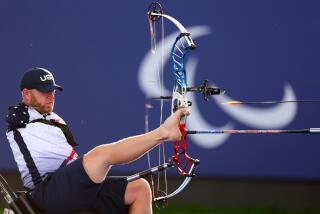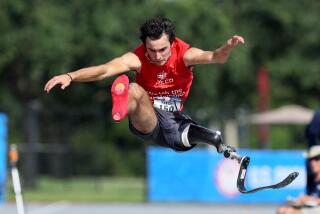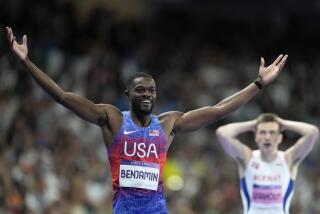Parry and Thrust : Two Days After Roger Bannister Broke Four Minutes in the Mile, USC Graduate O’Brien Broke 60 Feet in the Shotput
Forty years ago today, a USC graduate named Parry O’Brien broke an athletic barrier and went on to set a standard few in sports have since surpassed.
On May 8, 1954, on the floor of the Los Angeles Memorial Coliseum, O’Brien put the shot where every other post-World War II shotputter had been trying to put it--beyond the 60-foot mark.
Thus, two track and field barriers had fallen within 48 hours. Two days before, a British medical student and miler, Roger Bannister, had broken the four-minute barrier.
Now, a powerful 22-year-old Santa Monica athlete whose single-minded, sharply focused competitive spirit was already a legend in his sport, was at center stage.
On this sunny Saturday afternoon in 1954, he was already the holder of the world shotput record at 59 feet 2 1/2 inches. He was competing in a special shotput added to a USC-UCLA dual meet.
That O’Brien was the first man to put the shot 60 feet was no surprise. As a USC senior, he had won the Olympic gold medal at Helsinki in 1952--and would go on to win another in 1956.
And in the spring of 1954, he was roughly midway in a streak of 116 consecutive shotput victories.
Nevertheless, anticipation mounted with his first warm-up throw that day, and most in the Coliseum crowd of 5,000 then knew that this, surely, was the day O’Brien would get Babe Ruth’s number--60.
In his revolutionary half-turn style--starting with his back to the target area--and wearing sweats and tennis shoes, O’Brien’s first warm-up bounced just past the 60-foot chalk line. It was measured, unofficially, at 60-4.
On the first of his six official throws, the 16-pound shot slipped off his hand, a foul.
Then:
--60-5 1/4.
--60- 1/2.
--59-10 1/4 (foul).
--59-10 1/4.
--58-10 3/8.
Besides breaking 60 feet, O’Brien had beaten his world record on four of his six throws.
It can be said today of Parry O’Brien that he not only mastered his event and then dominated it, he revolutionized it, too.
Until O’Brien, shotputters lumbered across their seven-foot circle at a 90-degree angle to the throwing area, nearly coming to a stop just before shoving their steel spheres into the air.
O’Brien, in 1951, found a better way. He had just lost at Fresno’s West Coast Relays to Otis Chandler, who later became publisher of The Times.
The next morning, his father was awakened at 3 a.m. by the sound of grunts and thuds in the vacant lot next to their Santa Monica home.
Parry was putting the shot by street light. And he was launching it from a 180-degree turn, starting with his back to the throwing area.
“Dad, look what I’ve found,” he said, and demonstrated.
Chandler said recently that he likes to take credit for an assist on the first 60-foot shotput, for upsetting O’Brien at Fresno . . . and for some advice.
“I was heavy into weight training at that time, when few other athletes or coaches were,” Chandler said.
“In those days, if you wanted to lift weights, you literally had to do it when the coach wasn’t watching. Coaches associated weightlifting then with body-beautiful stuff. Olympic-style power lifting, of course, had nothing to do with that.
“Parry, like a lot of other athletes, believed weightlifting would make you so muscle-bound you couldn’t move. I said, ‘Look, I’m not a natural at this, but you are. Come on, lift weights. Get stronger.’
“(Jim) Fuchs would have easily made 60 feet if he’d lifted weights, but he wouldn’t do it, either.
“Parry did, and he went from about 210 (pounds) to 240 and continued to improve over a long period of time.”
O’Brien, who had also been first to reach 59 feet, went on to become the first shotputter to break 61, 62 and 63 feet. He set 13 indoor and outdoor world records. He was on four Olympic teams.
Said Fuchs, who dominated the shotput in the five years after World War II:
“I didn’t believe in weight training then, and I didn’t know many shotputters who did, other than Chandler. I competed at around 212 pounds. I probably could have gotten up to 260 with weights.”
Fuchs also said that he, not O’Brien, had first tinkered with the half-turn style.
“I came to realize that we were all coming to a stop and cocking our bodies with the 90-degree turn,” he said. “A Yale physiology teacher told me that your legs were three times stronger than your arms, so I was just trying to find a way to get my legs into it.
“I was turning 120 or 130 degrees by the time I retired, in the early 1950s. Parry accentuated (the style), but it became known as the O’Brien technique.”
When interviewed recently, O’Brien seemed happiest that the central theme to his athletic career was constant improvement.
“One thing I’m really proud of is that at four Olympics, I improved my mark every time,” said O’Brien, now 62 and retired from a banking career. He lives in Mission Hills and will be inducted into the USC athletic Hall of Fame at the inaugural ceremony and dinner May 21 at the Forum.
O’Brien won the gold medal in 1952 at 57-1 1/2, repeated in 1956 at 60-11 1/4, was second in 1960 at 62-8 1/2 and fourth in 1964 at 63-0.
At 34, in 1966, he achieved his best mark, 64-9 1/2.
And for 10 consecutive years, he was ranked among the world’s top 10 in the discus.
He was among the first athletes to bring psychological warfare to sports.
“Parry was a tough guy to get to know, but he was really a bear in competition,” recalls USC track Coach Jim Bush.
“He wouldn’t talk with or look at anyone when he was competing. And then there was that little bottle he always brought to the meets. That bothered a lot of competitors.”
The taped-up bottle contained honey. But when he competed, O’Brien would never say what was in it. Yet he always made sure everyone saw it.
“I tried to get guys I competed against to be more worried about me than about what they were supposed to be doing,” O’Brien said.
Bush said, “I’ll always remember him as an athlete who totally mastered his event with discipline and dedication.”
Indeed, O’Brien defined discipline. The foot foul, even today, is common in the shotput.
O’Brien said he could recall foot-fouling “no more than two or three times” in his 16-year career.
Of O’Brien’s competitiveness, former world record-holder Randy Matson said, “There was always a feeling with Parry that if you didn’t get an early throw way out there, he was going to beat you. If it was close and it came down to his last couple of throws, he almost always won.”
O’Brien, Fuchs and Chandler all said the world record in their event would be about 67 or 68 feet today, had performance-enhancing pharmaceuticals never been introduced.
That indicts many, including Randy Matson, who broke the 70-foot barrier in 1965. Matson denies having used drugs.
“The influence of steroids on performance in the shot may be overstated,” he said.
“It seems perfectly possible to me a guy could go 75 feet without them. I do think steroids have benefited a lot of shotputters, but I don’t think it’s necessarily helped (advance) the world record. I never used them.
“When you see so many shotputters today who are so big, so strong--I think steroids have something to do with that. But it’s tough to call.
“To my mind, in the shot, there’s no substitute for sound weight training. I weighed 215 and had never lifted weights when I was a freshman at Texas A&M.; One year later, after a full year of weight training, I was 265.”
In any event, 40 years have passed since O’Brien’s historic achievement.
Fuchs, 65, owns a career-counseling business and lives in New York.
Chandler, 66, is a board member and chairman emeritus of Times Mirror.
Matson, 49, is director of the Texas A&M; alumni association.
And the world record in the shotput is 75-10 1/4.
More to Read
Go beyond the scoreboard
Get the latest on L.A.'s teams in the daily Sports Report newsletter.
You may occasionally receive promotional content from the Los Angeles Times.






